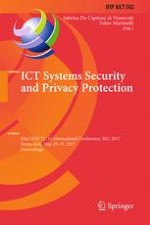2017 | OriginalPaper | Chapter
Ghost Patches: Fake Patches for Fake Vulnerabilities
Authors : Jeffrey Avery, Eugene H. Spafford
Published in: ICT Systems Security and Privacy Protection
Publisher: Springer International Publishing
Activate our intelligent search to find suitable subject content or patents.
Select sections of text to find matching patents with Artificial Intelligence. powered by
Select sections of text to find additional relevant content using AI-assisted search. powered by
